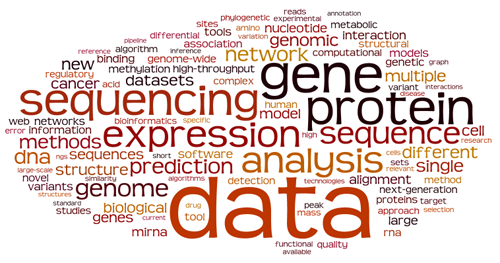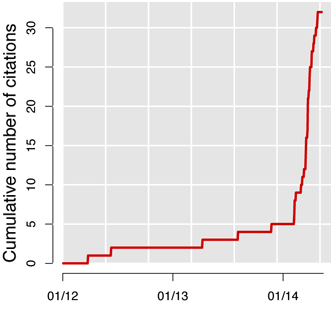•
the Blog
What is bioinformatics about?
By Guillaume Filion, filed under
PubMed,
journals,
bioinformatics,
information retrieval.
• 01 June 2015 •
A brief note published a few weeks ago initiated a discussion on the blogosphere about who is a bioinformatician and who is not. According to Wikipedia
bioinformatics combines computer science, statistics, mathematics, and engineering to study and process biological data.
To see how the community defines itself, I downloaded the abstracts of Bioinformatics from 2014 (for a total around 1000 articles, extracted the most relevant keywords and put the top 100 terms in a word cloud where a word size shows its frequency*.

Obviously, bioinformatics is about data, mostly gene/protein sequences and expression. It is also good to know that bioinformatics likes genomes and networks, and that it has more affinities with structural biology than with evolution.
The favourite organism of bioinformaticians is Homo sapiens, actually it is the only one mentioned in the word cloud, and when bioinformaticians work on a disease, it is cancer.
When bioinformaticians describe their work, it is “novel” and “new”, and what they talk about is “biological”, “different”, “multiple” and “single” (the last two are usually followed by “sequence alignment” and “nucleotide polymorphism”). It is also “functional” and “available”, but somewhat less. I expected it to be “fast” and “accurate”, but...
A flurry of copycats on PubMed
By Guillaume Filion, filed under
PubMed,
journals,
information retrieval.
• 04 October 2014 •
It started with a search for trends on PubMed. I am not sure what I expected to find, but it was nothing like the “CISCOM meta-analyses”. Here is the story of how my colleague Lucas Carey (from Universitat Pompeu Fabra) and myself discovered a collection of disturbingly similar scientific papers, and how we got to the bottom of it.
Pattern breaker
 CISCOM is the medical publication database of the Research Council for Complementary Medicine. Available since 1995, it used to be mentioned in 2 to 3 papers per year, until Feburary 2014 when the number of hits started to skyrocket. Since then, “CISCOM” surfs a tsunami of one new hit per week.
CISCOM is the medical publication database of the Research Council for Complementary Medicine. Available since 1995, it used to be mentioned in 2 to 3 papers per year, until Feburary 2014 when the number of hits started to skyrocket. Since then, “CISCOM” surfs a tsunami of one new hit per week.
But this is not what drew my attention, such waves are not unheard of on PubMed. For instance, the progression of CRISPR/Cas9, is more impressive. It was the titles of the hits that convinced me that something fishy was going on: all of them are on the model “something and something else: a meta-analysis”.
The strange pattern caught my attention, but I somehow missed its significance and put this in the back of my mind. It was only later that Lucas convinced me...
Shadow libraries
By Guillaume Filion, filed under
journals,
shadow libraries.
• 15 September 2014 •
 In Jorge Luis Borges’s short fiction Tlön, Uqbar, Orbis Tertius, the narrator discovers by accident the existence of a secret encyclopaedia. In this story more than in the others, Borges added many details that are actually true, in such a way that it is hard to tell the reality from the fiction. Needless to say, most would think that the secret encyclopaedia is pure fiction... and they would be wrong. Secret encyclopaedias do exist and they go by the name of “shadow libraries”.
In Jorge Luis Borges’s short fiction Tlön, Uqbar, Orbis Tertius, the narrator discovers by accident the existence of a secret encyclopaedia. In this story more than in the others, Borges added many details that are actually true, in such a way that it is hard to tell the reality from the fiction. Needless to say, most would think that the secret encyclopaedia is pure fiction... and they would be wrong. Secret encyclopaedias do exist and they go by the name of “shadow libraries”.
Academic publishing
In the course of developing PubCron (a personalized academic literature watch), I learned that PubMed references more than 2,000 new articles daily. For the vast majority of those papers, the authors pay about $1,000 as publication fees. In the bio-medical field alone, this is a $2 million gift to the publishing industry. Every day.
Gift is not the proper term. This money goes to scientific editors and in such amount, it should be sufficient to sustain about 20,000 professional editors. An editor working full time would publish 3 papers per month... not an unreasonable estimate considering that only a fraction of the manuscripts are published. This means...
What’s in a title?
By Guillaume Filion, filed under
PubMed,
journals,
information retrieval.
• 10 March 2012 •
Trying to come up with a name for the blog, I wondered what a good title should be. If you ever wrote a scientific article, you probably found yourself in the same situation. You try to surf the trend, mix in carefully selected buzzwords and present the work under its sexiest side. Sexy, that is, to the veterans. Admittedly, not everyone will crave to read “Epithelial cell adhesion molecule (EpCAM) complex proteins promote transcription factor-mediated pluripotency reprogramming” (no offense intended, I just took the first title that showed up in PubMed).
Meta-analysis of scientific literature tells us a lot about how science and scientific discourse change over time. A simple title word analysis of the articles published in Nature in an 8 year interval shows how some topics fell from grace, whereas others rose to the top.
The struggle-for-hype allows us to tell what scientists and editors find exciting at a given time. To play with this idea, I collected all the titles of the Nature articles published in 2002 and in 2010, and ran Wordle on them. The size of a word in the cloud is proportional to its occurrence in the corpus...
I’m the boss!!
By Guillaume Filion, filed under
motivation,
journals,
dialogue.
• 08 March 2012 •
“You know how scientists will communicate in the future, don’t you?”
“Of course I do!”
It is a shameless lie, I have no clue what Frédéric has in mind, but I don’t want to look stupid.
“And you Vincent, I bet you know it too... right?”
On this afternoon of 2004, somewhere on the south coast of Madagascar, Vincent gives one of his majestic puzzled looks. That was exactly what Frédéric had hoped for.
“Well, in the future, scientists will no longer publish in journals. They will have public lab notes. They will post their results on their personal Internet page, day by day... like a blog. Peer scientists will be allowed to leave their comments, criticize the protocols and the results. In short, the information will go directly from the producers to the consumers, and it will spread much better because science will become open source.”
I believed it then.
But now, I just became an independent researcher. I have my own team. I am the boss!! And I realize that Frédéric was wrong. To stay in research you need a good track record. And as far as track...

